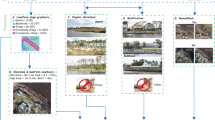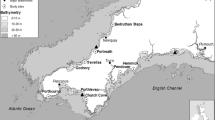Abstract
The geographic area that the Joint Airborne LiDAR Bathymetry Technical Center of Expertise (JALBTCX) covers with their Light Detection and Ranging (LiDAR) program allows for researchers to quantify coastal metrics on national, regional and local scales. As these studies progressed, it has become apparent that software needs to be developed to quantify coastal change from LiDAR at multiple scales. The purpose of this research is to provide coastal managers with quantities and locations of change that occurred on eastern US coastlines, and if the researcher would like additional information, provide the tools necessary for additional metrics to be quantified and additional questions to be answered.
JALBTCX LiDAR data were delivered as 1332 filtered surfaces in standard US Army Corps of Engineers (USACE) 5 km blocks from the Maine coastline to the Florida/Alabama border. Multiple processing steps and custom conversion tools were written in Python and incorporated into the ArcGIS software environment via ESRI’s ArcToolbox. Coastal metrics for almost 3300 km of coastline were quantified between two time periods in this study. Metrics included shoreline change, volume change, subaerial volume change and above mean high water volume change.
The JALBTCX toolbox allows for multiple coastal metrics to be extracted and directly compared. Maine, Maryland and Florida east coast are examples of areas with landward shoreline migration and positive subaerial volume. Volume change and above MHW volume change should be the utilized metrics when data sets with gaps at the shoreline elevation limited quantifications for shoreline and subaerial volume change.
Similar content being viewed by others
References
CB&I 2016 JALBTCX Toolbox Version 1. CB&I Manual 153707-PE-MA-000001, p37
Coastal Planning & Engineering 2011 Elevation Change Analysis, Phase II: Florida Coastline. Boca Raton, FL, p21
Coastal Planning & Engineering 2009 Gulf Coast Elevation Change Analysis Report: Phase I. Boca Raton, FL, p23
Crowell M, Leatherman SP, Buckley MK (1991) Historical shoreline change: error analysis and mapping accuracy. J Coast Res 14(3):1025–1033
Douglas BC, Crowell M, Leatherman SP (1998) Considerations for shoreline position prediction. J Coast Res 14(3):1025–1033
Galgano FA, Douglas BC, Leatherman SP (1998) Trends and variability of shoreline position. J Coast Res 26:282–291
Houston JR, Dean RG (2011) Sea-level acceleration based on U.S. tide gauges and extensions of previous global-gauge analyses. J Coast Res 27(3):409–417
List J, Farris AH, Sullivan C (2006) Reversing storm hotspots on sandy beaches: spatial and temporal characteristics. Mar Geol 226(3–4):261–279
Moore LJ, Ruggiero P, List JH (2006) Comparing mean high water and high water line shorelines: should proxy-datum offsets be incorporated into shoreline change analysis. J Coast Res 22(4):894–905
Morton RA, Paine JG, Gibeaut JC (1994) Stages and durations of post-storm beach recovery, southeastern Texas coast, USA. J Coast Res 10(4):884–908
National Oceanic and Atmospheric Administration (NOAA) (2012) NOAA’s state of the coast. Economy: Ports – Crucial Infrastructure. Silver Spring, MD. http://stateofthecoast.noaa.gov/ports/
Robertson W, Zhang K, Whitman D (2007) Hurricane-induced beach change derived from airborne laser measurements near Panama City, Florida. Mar Geol 237:191–205
Robertson W, Whitman D, Zhang K, Leatherman SP (2004) Mapping shoreline position using airborne laser altimetry. J Coast Res 20(3):884–892
Robertson W, Zhang K, Whitman D, Leatherman SP (2005) Shoreline and beach volume change before and after the 2004 hurricane season, Palm Beach County, Florida. Shore Beach 73(2–3):79–84
Sallenger AH, Krabill WB, Swift RN, Brock J, List J, Hansen M, Holman RA, Manizade S, Sontag J, Meredith A, Morgan K, Ynkel JK, Frederick EB, Stockdon H (2003) Evaluation of airborne topographic lidar for quantifying beach changes. J Coast Res 19(1):125–133
Shrestha RL, Carter WE, Lee M, Finer P, Sartori M (1999) Airborne laser swath mapping: accuracy assessment for surveying and mapping applications. J Am Congr Surv Mapp 59:83–94
Stockdon HF, Sallenger AH, List JH, Holman RA (2002) Estimation of shoreline position and change using airborne topographic lidar data. J Coast Res 18(3):502–513
Thieler, E.R., Himmelstoss, E.A., Zichichi, J.L., and Ergul, A., 2009. The Digital Shoreline Analysis System (DSAS) version 4.0 – an ArcGIS extension for calculating shoreline change. U.S. Geological Survey Open-File Report 2008–1278
Thom BG, Hall W (1991) Behavior of beach profiles during accretion and erosion dominated periods. Earth Surf Process Landf 16:113–127
Watson PJ (in press) Acceleration in U.S. mean sea level? A new insight using improved tools. J Coast Res:15
Weber, K.M., List, J.H., and Morgan, L.M., 2005. An operational mean high water datum for determination of shoreline position for topographic LiDAR data. U.S. Geological Society Open-File Report 2005–1027
Wozencraft JM, Lillycrop WJ (2006) JALBTCX Coastal Mapping for the USACE. Int Hydrogr Rev 7(2):28–37
Zhang K, Whitman D, Leatherman S, Robertson W (2005) Quantification of beach changes caused by Hurricane Floyd along Florida’s Atlantic coast suing airborne laser surveys. J Coast Res 20(1):123–134
Author information
Authors and Affiliations
Corresponding author
Editor information
Editors and Affiliations
Rights and permissions
Copyright information
© 2018 Springer International Publishing AG
About this chapter
Cite this chapter
Robertson, Q., Dunkin, L., Dong, Z., Wozencraft, J., Zhang, K. (2018). Florida and US East Coast Beach Change Metrics Derived from LiDAR Data Utilizing ArcGIS Python Based Tools. In: Botero, C., Cervantes, O., Finkl, C. (eds) Beach Management Tools - Concepts, Methodologies and Case Studies. Coastal Research Library, vol 24. Springer, Cham. https://doi.org/10.1007/978-3-319-58304-4_12
Download citation
DOI: https://doi.org/10.1007/978-3-319-58304-4_12
Published:
Publisher Name: Springer, Cham
Print ISBN: 978-3-319-58303-7
Online ISBN: 978-3-319-58304-4
eBook Packages: Earth and Environmental ScienceEarth and Environmental Science (R0)




